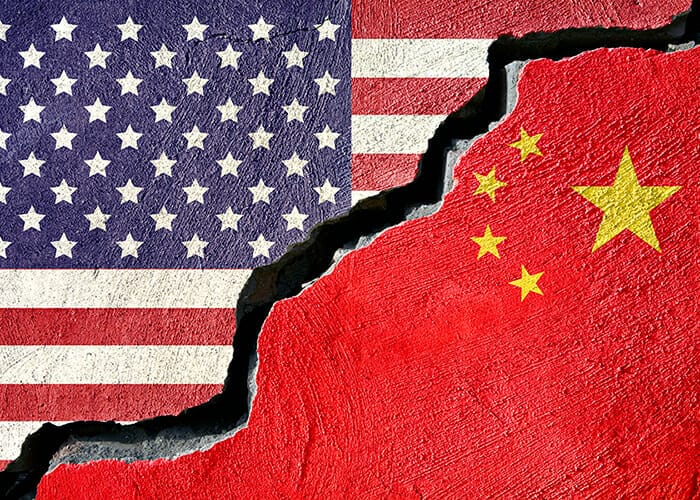President Xi Jinping, during his first visit to the US in 2012, called for a “new type of great-power relations in the 21st century”. This statement – a version of which had been uttered with far less notice by several of Xi’s predecessors – was taken to imply that China seeks recognition as a superpower on a par with the US.
For most of recorded history, China was the pre-eminent power. Back in 1784, when the first US ship landed in China, at the port of Guangzhou, carrying American-grown ginseng and some New World silver to exchange for valuable brick tea, America was a small coastal nation with a population of 3.9 million and a mostly farming economy. China then had a population of 300 million, and accounted for an estimated 40 per cent of global GDP.
History played a cunning trick, however. Not long after the founding of the US, China happened to go into prolonged decline. Its tribulations lasted the better part of a century and a half. Without that circumstance, one is hard pressed to imagine the US becoming a superpower, given the importance to US prosperity and standing of dominating East Asia. By 1979, China’s claim on global output was a minuscule 1.5 per cent, despite having nearly 1 billion people. In contrast, the US, with less than a quarter of China’s population, boasted a 27 per cent GDP share.
Stunning ascent
Then, history surprised once more. Over the ensuing four decades, China’s GDP, in dollar terms, skyrocketed from about $270 million to $12 trillion. Today, the country accounts for more than 15 per cent of nominal world output. The US share sits just above 20 per cent. Who, in 1979, had any inkling of such a turnabout? Be careful when forecasting the future.
Several factors drove China’s stunning ascent. But one key was Deng Xiaoping’s strategic reorientation away from the Soviet model, towards a de facto economic partnership with the US. The Chinese leader had observed the miraculous revival of his neighbour Japan from the ashes of the Second World War, followed by the rapid rise of South Korea and Taiwan, all of which had adopted a strategy of selling into the ravenous US market.
In 1979, Deng became the first Chinese Communist leader to visit the US, which the next year opened its markets to China, just as it had done for the East Asian tigers. Chinese industriousness proved to be stupendous; still, it is not too much of an exaggeration to say that the colossal appetites and purchasing power of the American middle class created the Chinese middle class.
The interconnections have run deep. China and the US had combined in the Second World War to defeat Japan’s attempted seizure of East Asia. And, notwithstanding China’s turn to communism and the two powers’ clash from opposite sides of the Korean War, the US initiated a rapprochement with Beijing, as a counterweight to Moscow, then fully supported China’s rise, fantasising that as that country grew rich, it would become more like America.
Delusions aside, China’s revival has taken place entirely in a US-dominated world. The current situation – with the two countries simultaneously great powers – is a first.
Modern China confounds
What happens next? One of the fundamental problems with answering that question derives from China’s rebounding history. Everything we think we know about the importance of the rule of law and secure property rights, the necessity of freedom of information, the superiority of private companies, domestic political competition as sine qua non, and much else, we formulated without having to take China’s example into account. After all, China was down.
Now, many experts have been applying the laws of social science to a resurgent China and predicting the authoritarian system’s demise. However, decade after decade, the downfall fails to occur. Perhaps China will eventually be undone by the so-called middle-income trap; that is, it will stop developing for want of high-quality institutions, and suffer social upheaval. Bad debt might cause a financial and then a political bank run. Corruption could finally stop being a lubricant and become fatally corrosive, bringing down the whole system.
As the expression goes, China at some point must cease to defy gravity. In the meantime, however, its state performs a great deal better than many experts think it should, and so does its economy.
Never has a state this opaque become this wealthy and mighty. True, we have the intriguing cases of Germany and Japan before the First World War – two authoritarian regimes that had highly dynamic economies. But both were more politically pluralist and open than today’s Communist-ruled China.
Analysts of the rise of imperial Germany and imperial Japan are still debating whether it was their authoritarian regimes, or the nature of the international system of the time, that rendered them externally aggressive. This debate has implications for gaming the behaviour of contemporary China. What is certain is that imperial Germany and imperial Japan were profoundly influenced by Great Britain’s policies and global posture. Today, China’s trajectory is intricately intertwined with that of the US.
Doubts about the US
Beijing’s ability to continue on its upward path is not the only confounding variable. The institutional stability and overall reliability of the US have come to be doubted, too. Observers have gaped as the US administration deliberately undermines its own surpassing assets – democratic government, open markets, and mutually beneficial alliances. Behind this transfixing attempted suicide lie longer-term failings in understanding and responding to China.
Investors have been put on notice by the White House’s erratic declarations of trade penalties, which address genuine issues but in self-defeating fashion, and China’s vows of retaliation. Each government is seeking to demonstrate resolve. There is much more skirmishing to come, and no end in sight to the vicious rivalry over artificial intelligence, bioengineering and other frontiers of technology. But rather than the expected deepening economic frictions, it is the unexpected or the half-forgotten – that old problem of Taiwan – that is poised to shatter everything.
China has made a point of reclaiming territories it views as historic possessions, most recently Hong Kong, and Xi personally reaffirmed Taiwan as Chinese territory and a “core interest”. The modernising People’s Liberation Army, for its part, is at last on the verge of acquiring the amphibious landing capacity necessary to seize Taiwan by force.
Such an action might seem so self-destructive, economically, as to be out of the question. But opinion polls of the island’s inhabitants have recorded a trend decisively away from Chinese identity toward a separate Taiwanese identity, the opposite of what mainland China had hoped for from stronger bilateral economic integration. About 60 per cent of the island’s residents consider themselves exclusively Taiwanese, 3 per cent say they are Chinese, and 30 per cent say they are both. For those under 40 years old, Taiwanese identity – associated with democracy, rule of law, freedom of speech and assembly – climbs towards 70 per cent. Connect this fateful evolution to Xi’s aspirations to achieve a historic reign, and to America’s paper commitment to defend Taiwan’s sovereignty, and one can see just how combustible is this flashpoint.
Can Beijing allow solidification of what, from its point of view, is a permanent separatist identity? Significant economic pressure has not chastened the Taiwanese. It seems only a matter of time before the Communist party leadership feels compelled to intervene. And if the US were to fail to reverse a mainland takeover of Taiwan, that would demolish American credibility throughout Asia, a perhaps too-tempting proposition for Beijing.
Americans and Chinese, John Pomfret’s magisterial The Beautiful Country and the Middle Kingdom states, have repeatedly been swept up into “rapturous enchantment begetting hope, followed by disenchantment, repulsion and disgust, only to return to fascination once again”. One hopes he’s right – and that relations soon re-enter the front end of that cycle. For now, the two powers are on the road to conflagration.
Pomfret concludes that the US and China are locked “in an entangling embrace that neither can quit”. Xi’s evocation, in his 2012 speech and since, of revived superpower status and rewriting of the international rules, resonates profoundly with the mainland Chinese people. So does Beijing’s forward posture in the South China Sea, which the US Pacific fleet patrols. The US administration must figure out not only the Chinese regime’s objectives and bottom line, but also how Chinese decision-makers view US objectives, and whether they consider US statements credible. Washington’s escalating confusion and ineptitude over how to handle China’s predictable, eventual refusal to accept subordinate status in a US-configured world does not inspire confidence.
As the relative power shift continues and we puzzle over the varying degrees of resilience or brittleness of the two different systems, we remain bereft of answers to the question of what their stable coexistence might look like. Moreover, even if we knew the contours of that peaceful win-win equilibrium going forward, we would still have to figure out how both sides would get there.
Business as usual is upending business as usual. Investors could play a part in a spiraling destabilisation, betting on making money from anticipated dislocation.




